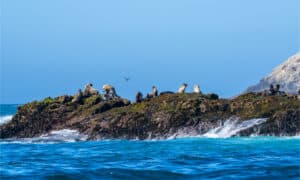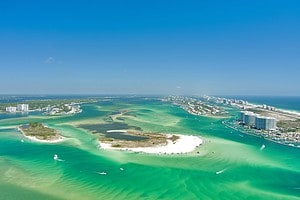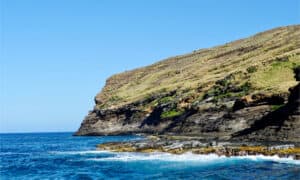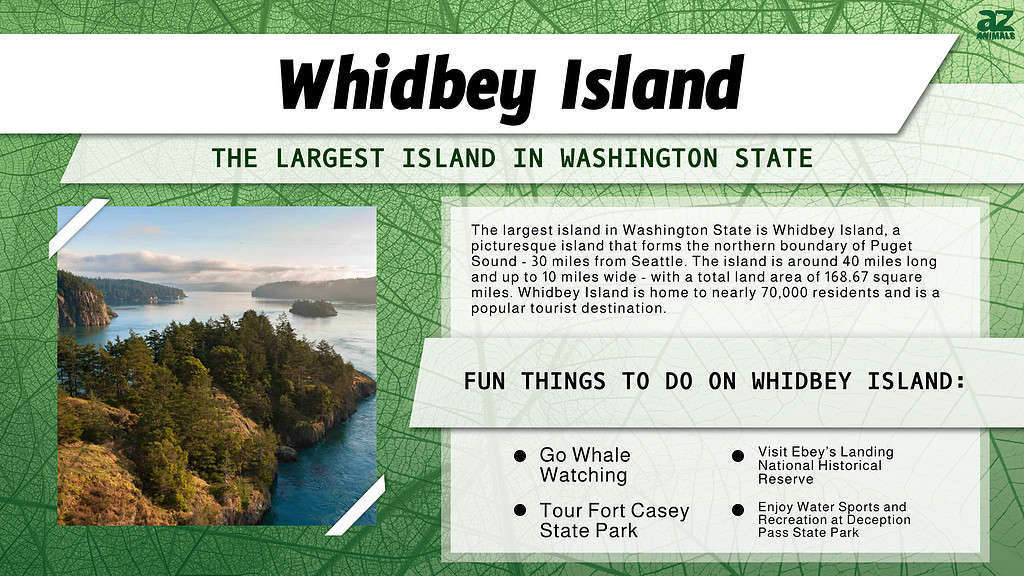
The largest island in Washington State is a verdant paradise brimming with life and natural beauty. From towering evergreens and old-growth forests to rugged shorelines and pristine beaches, this idyllic haven is home to many fascinating creatures. Visitors can observe majestic orcas and playful seals, along with deer and beautiful birds. There is plenty to see and discover. So, let’s embark on a journey and discover the largest island in Washington State and the incredible creatures that call it home!
What Is the Largest Island in Washington State?
The largest island in Washington State is Whidbey Island, a picturesque island that forms the northern boundary of the Puget Sound. You can find Whidbey Island just 30 miles from Seattle, between the I-5 corridor of western Washington and the Olympic Peninsula. From north to south, Whidbey Island is around 40 miles long. The island is 1.5 to 10 miles wide, and its total land area is 168.67 square miles.
The Salish people gave the island the name “Tscha-kole-chy”, or “the place of the long, narrow island”. The Coast Salish people also referred to it as “Whulge Island”, an onomatopoetic term that came from the Lushootseed language. “Whulge” refers to the splashing or churning sounds of the waves. Today the island is most commonly known as Whidbey Island, named after Joseph Whidbey. Whidgey was a sailing master who accompanied George Vancouver on an exploration of the island’s waterways aboard the HMS Discovery in 1792.
Whidbey Island is part of Island County in Washington State and has about 69,480 residents (as of the 2010 census). Tourism is a major part of the economy on Whidbey Island, bringing in millions of dollars and supporting thousands of jobs. Thanks to the steady flow of visitors to the island, tourism also generates much of the tax revenue for the island, providing many essential services like roads, libraries, and schools.

Whidbey Island is a popular spot worldwide due to its incredible landscapes and stunning vistas.
©Edmund Lowe Photography/Shutterstock.com
What Things Can You Do on Whidbey Island?
There is an endless supply of things to do on Whidbey Island, whether you enjoy outdoor adventures, history, culture, art, or shopping. Of course, Whidbey Island is especially popular for those who come to enjoy its many diverse and beautiful landscapes.
On the northern part of the island, you’ll find yourself surrounded by rolling ancient forests, gently rolling hills, and endless fields of lush farmland. But if you head over to the south side of the island, you’ll find all sorts of wild and rugged areas with pristine beaches, towering cliffs, and hidden inlets just waiting to be explored. Whidbey Island is also home to many parks, like Ebey’s Landing National Historical Reserve, Fort Casey State Park, and Deception Pass State Park.
Ebey’s Landing National Historical Reserve
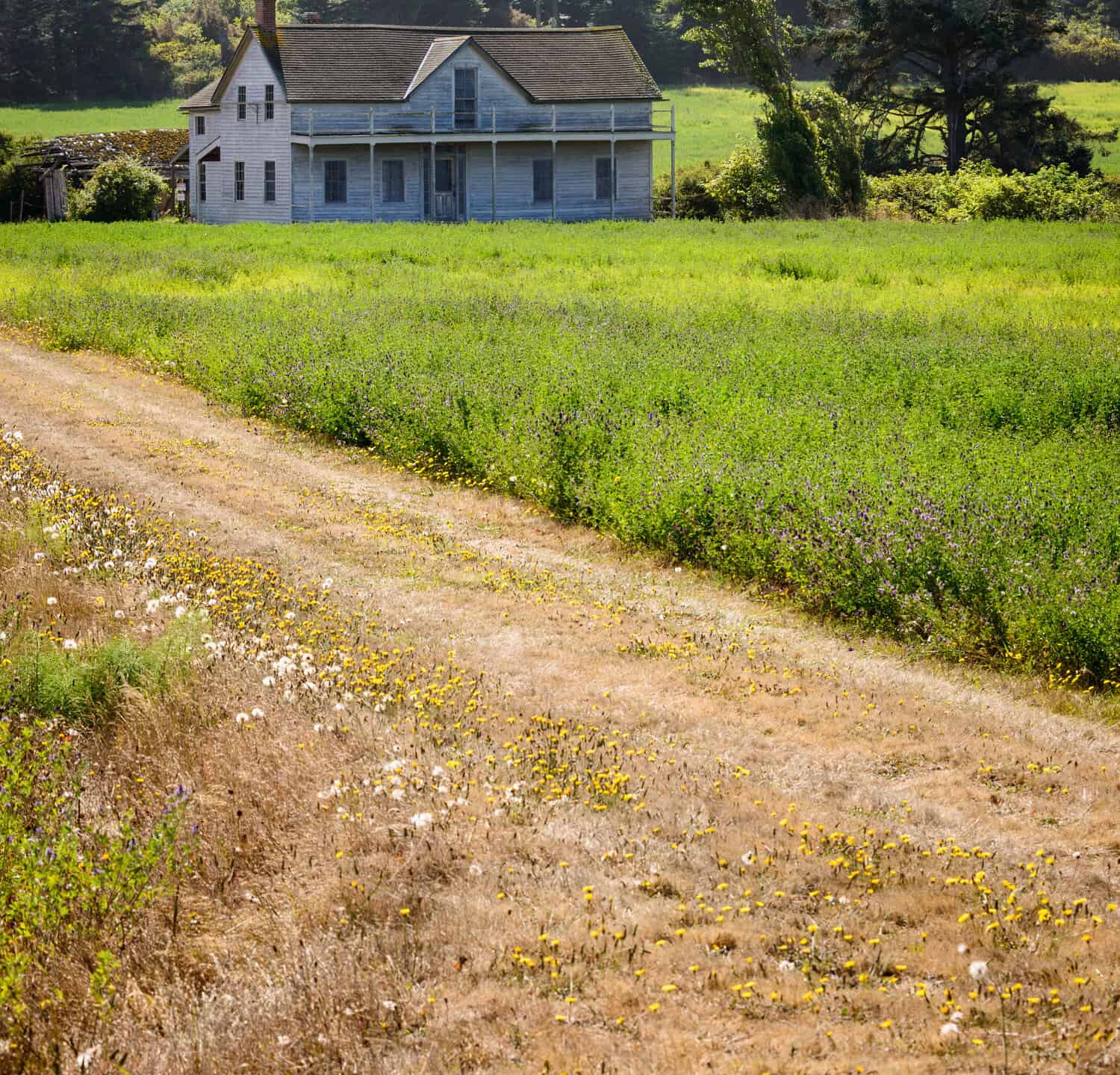
The historic farms at Ebey’s Landing National Historical Reserve were claimed in the 1850s.
©Zack Frank/Shutterstock.com
Ebey’s Landing National Historical Reserve is a treasure trove of stories and history, preserving the rich legacy of exploration and settlement from the nineteenth century to the present day. Visitors here will encounter rustic, historic farms that have been lovingly tended for generations.
This is also where you will find Coupeville, a lovely seaport town full of natural beauty and cultural history. It is one of the oldest towns in Washington State, with several well-preserved buildings from the nineteenth century. The town also has many charming seafood restaurants, stunning views of Penn Cove, unique shops and art galleries, and amazing whale-watching tours. You can also visit the Island County Historical Museum to learn more about Whidbey Island. It has fascinating historical collections that reach all the way back to the Ice Age.
Fort Casey State Park

Fort Casey State Park is home to the Admiralty Head Light, a beautifully restored lighthouse from 1903!
©Edmund Lowe Photography/Shutterstock.com
Located within Ebey’s Landing National Historical Reserve, Fort Casey State Park is another amazing place to visit on Whidbey Island. Fort Casey — along with Fort Flagler and Fort Worden — formed the “Triangle of Fire”, a protective ring for the Puget Sound in the late 1800s and early 1900s.
Today, Fort Casey Historical Park encompasses 999 acres. Visitors can enjoy picnicking, boating, diving, fishing, strolling along the beach, bird watching, boating, and hiking. Part of the spectacular Pacific Northwest National Scenic Trail is also found in Fort Casey State Park. And, if you’re looking for a unique underwater adventure, you can go diving at Fort Casey’s Keystone Underwater Park. You might catch a glimpse of beautiful sea creatures like octopuses, crabs, sea cucumbers, wolf eels, and more!
Deception Pass State Park
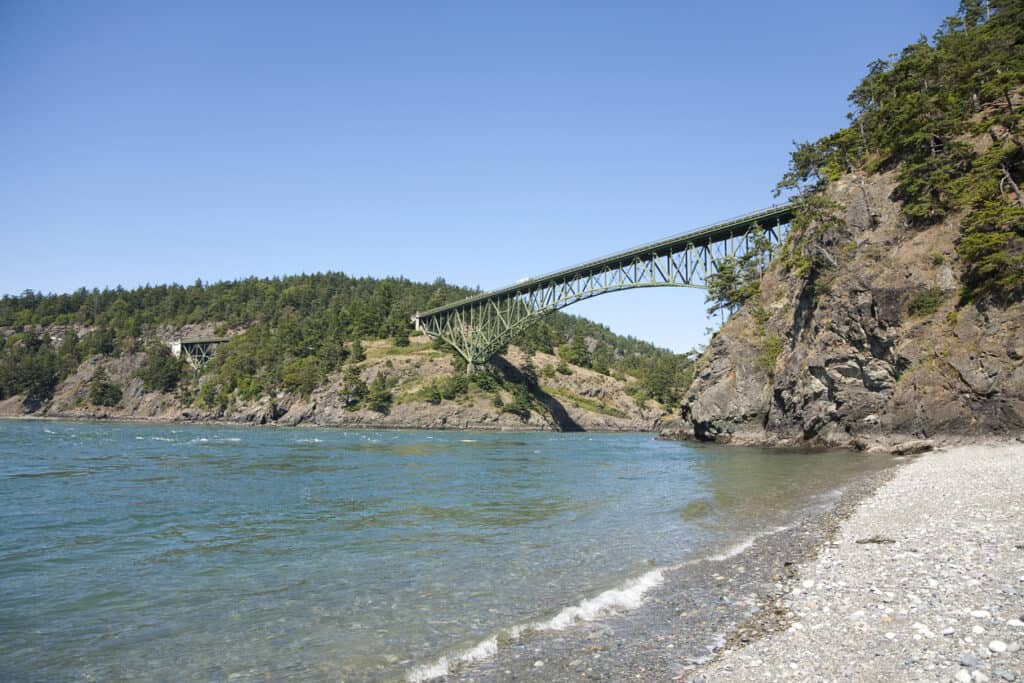
Whidbey Island and Fidalgo Island are connected by the Deception Pass Bridge.
©iStock.com/nesneJkraM
One of the most popular state parks in Washington State is Deception Pass State Park, located on Whidbey Island and Fidalgo Island. This amazing 3,854-acre park is home to part of the PNT as well as many other trails for hiking, biking, and horseback riding.
If you’re looking to enjoy the marine aspects of the park, you can check out the Rosario Tide Pools where you can take a tour of these unique underwater worlds. In addition, the park has 77,000 feet of saltwater shoreline to explore, as well as three beautiful lakes. There are also plenty of campsites if you want to stay for more than just a day. There are also fun activities like bird watching, wildlife viewing, swimming, boating, diving, fishing, crabbing, and even whitewater kayaking. The park also has tours, concessions areas, and two amphitheaters.
When Is the Best Time to Visit Whidbey Island?
You can visit Whidbey Island any time of the year and find a plethora of fun things to do and see. In fact, the island’s weather is typically mild all throughout the year. However, there are certain seasons that are better for specific activities:
- Weather: If you’re hoping for sunny, warm weather, you’ll want to head to Whidbey Island during the summer months, from June through August.
- Crowds: For those concerned about large crowds, visiting from May to June and September to October are great times when there are fewer people on the island.
- Whale Watching: The best times to see whales or take whale-watching tours on Whidbey Island are during migration seasons, in the spring (April through May) and the fall (September through October).
- Hiking and Camping: The summer months (June through August) are the best time for hiking and camping, particularly if you like warmer weather. However, many trails and campgrounds are also open all year round.
- Culture and Towns: Many visitors come to Whidbey Island to immerse themselves in the charming culture of its historical small towns and villages. However, towns and villages on the island are typically most lively during the summer months. Some even host festivals during the summer or early fall, such as eclectic farmer’s markets and the Coupeville Arts & Crafts Festival.
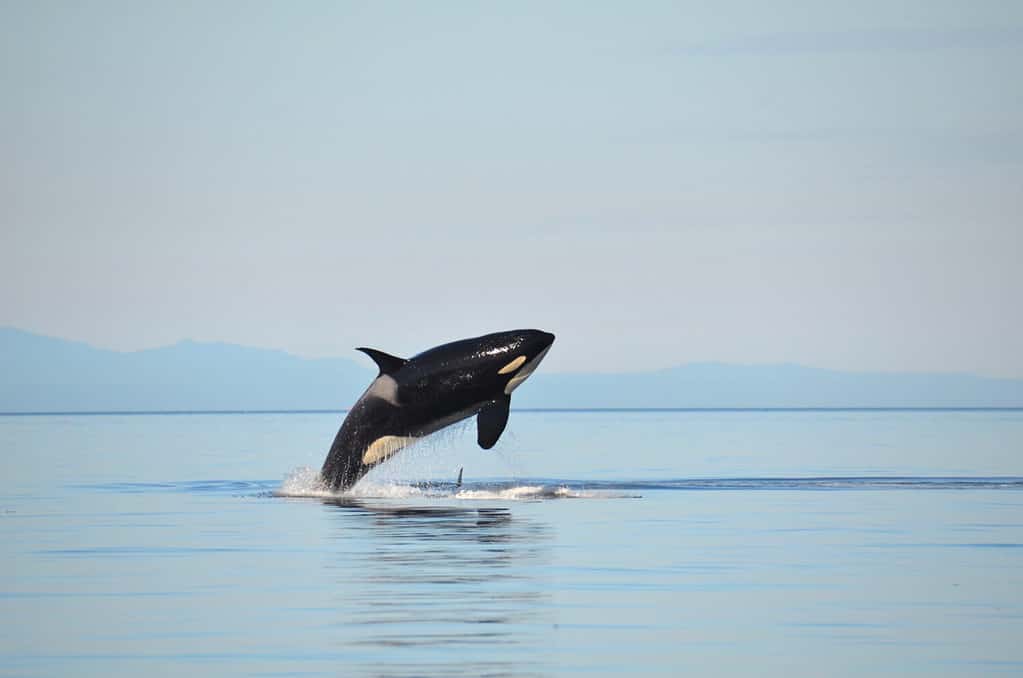
One of the most popular activities on Whidbey Island is whale watching.
©Monika Wieland Shields/Shutterstock.com
What Plants Live on Whidbey Island?
The climate on Whidbey Island is a perfect Pacific-northwestern paradise, with mild winters, cool summers, and plenty of rain. Down south you’ll find many plants and flowers reminiscent of mainland Washington. There are towering Douglas firs, sprawling big leaf maples, majestic red alders, fragrant western red cedars, lush Pacific madrones, and western hemlocks reaching toward the sky.
As you move further north on the island, the terrain begins to transform. The south’s abundant blue evergreen huckleberries begin to fade away, making way for towering Oregon-grapes and red huckleberries, as well as showstopping flowers like the native Pacific rhododendron. Deciduous Garry oak trees also feature prominently on the northern part of Whidbey Island, which is where Oak Harbor got its name. Grand fir also reigns supreme on this side of the island, accompanied by shore pine and Sitka spruce.
During the spring and summer months, wildflowers bloom all across Whidbey Island. You can enjoy fields filled with flowers like bluebells, buttercups, daisies, columbines, and Indian paintbrushes. For more deliberate landscaping, Meerkerk Gardens provides lovely and whimsical areas. You can stroll along its 43 acres of natural woodlands as well as 10 acres of colorful display gardens. And, during the annual Whidbey Island Garden Tour, many beautiful private gardens are also opened to the public to enjoy as well.

The Pacific rhododendron
(rhododendron macrophyllum) is the official state flower of Washington State.
©Thomas Hagenau/Shutterstock.com
Where is Whidbey Island Located on a Map?
Whidbey Island lies within Puget Sound, located just north of Seattle, Washington. This island’s diverse landscape encompasses shorelines, elevated hills, and fertile farmland. At its northwestern extremity, Deception Pass State Park has beautiful panoramic vistas from its cliffs, and forest trails, to its freshwater lakes.
Here it is on a map:
What Animals Live on Whidbey Island?
With so many lush and vibrant habitats, you can expect to see many different types of animals living on Whidbey Island. Its shoreline runs along the Puget Sound, and marine animals like stellar sea lions, harbor seals, and river otters are common. Whale watching is another popular pastime on Whidbey Island. If you take a boat tour you might spot humpback whales, gray whales, or even orcas. There are also thousands of invertebrate species living in the waters near the island, like sea urchins, oysters, clams, sea stars, and crabs.
Whidbey Island has four lakes (Goss Lake, Lone Lake, Deer Lake, and Cranberry Lake), providing homes to a wide diversity of animals. Dabbling ducks, harlequin ducks, oystercatchers, marsh wrens, loons, mergansers, great blue herons, and kingfishers are just a few of the birds you can spot along the lakes’ freshwater shores. The island’s many fields and woodlands are also home to hundreds of bird species like nuthatches, great horned owls, warblers, chickadees, eagles, harriers, woodpeckers, kinglets, and creepers.
Whidbey Island is also home to many smaller and medium-sized mammals, like rabbits, coyotes, and foxes. Rabbits — well, bunnies, in particular — are an especially common sight on the south end of Whidbey Island in Langley. For many years, bunnies were featured in the Island County Fair, and the escapees of these events have since proliferated. Today, bunnies have become part of everyday life in Langley, happily hopping all around the city.
The most common large mammals on the island are Columbian black-tailed deer (Odocoileus hemionus columbianus) — they can be found almost anywhere on Whidbey Island. However, the largest mammal living on Whidbey Island is a 6-foot-tall, 1,000-pound bull elk — yep, just one!
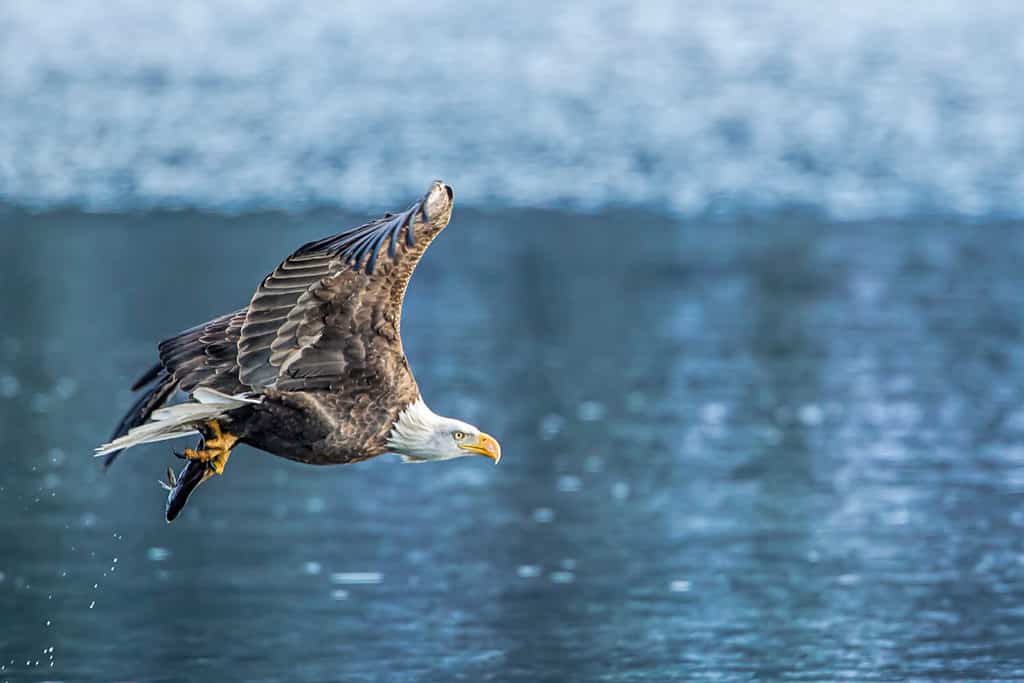
Eagles are just one of the many bird species you might spot on Whidbey Island.
©Gregory Johnston/Shutterstock.com
Bruiser, Whidbey Island’s Only Elk
The only elk living on Whidbey Island, Bruiser, swam across Skagit Bay back in 2012 and hasn’t left the island since. Although swimming long distances isn’t uncommon for elk, they usually return home — but over a decade later, Bruiser is still living all alone on Whidbey Island!
Don’t worry, though, Bruiser doesn’t seem bothered by his singled-out status. He particularly likes to hang out in the 88-acre Donald Brogman Nature Preserve and Strawberry Point on the north side of the island. The area is covered with tall forests, apple trees, and green shoots — giving him plenty to feast on without any competition.
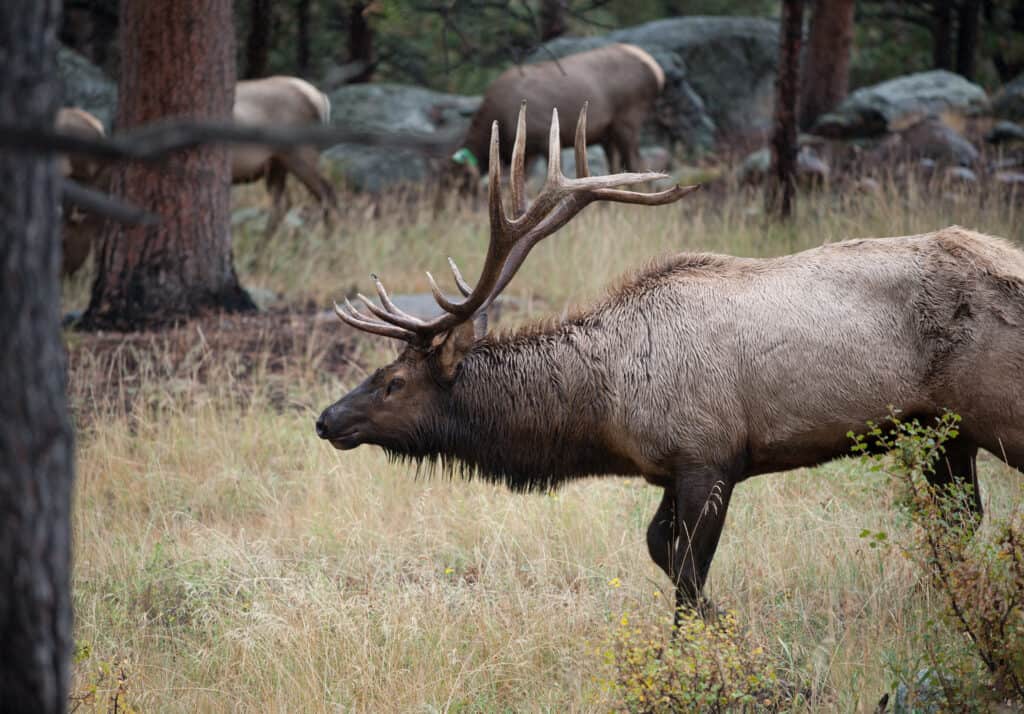
Elk typically live eight to 12 years in the wild, although in captivity they can live more than 20 years.
©Tony Campbell/Shutterstock.com
Thank you for reading! Have some feedback for us? Contact the AZ Animals editorial team.




